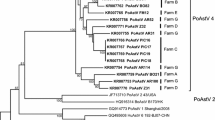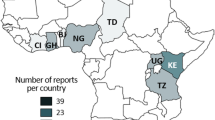Abstract
Several emerging viral agents related to gastroenteritis are distributed in human and animal populations and may contaminate the environment due to anthropic activities. The objective of this study was to analyze the seasonal contamination by enteric virus and coliforms in water from streams in the Vale do Taquari, draining a large number of pig farms. Microbiological contamination was evidenced by the detection of total and thermotolerant coliforms, reaching their peak in December. Hepatitis E virus (HEV), Enterovirus-G (EV-G) genome, and Sapelovirus-A (SV-A) genome were not detected. On the other hand, Rotavirus (RV) was detected in 3% (1/32) of the samples, whereas Teschovirus-A (PTV) was detected in 6% (2/32). This is the first detection of PTV in environmental samples in Brazil, pointing that the virus is being shedded from swine herds to watersheds. Human mastadenovirus (HAdV) was the most frequent detected viral agent in 9.3% (3/32) with values of 2.54 × 105, 7.13 × 104, and 3.09 × 105 genome copies/liter (gc/L). The circulation of coliforms and viral pathogens is noticeable due to anthropic activities and to the management of animal waste from the pig farming. In this way, enteric viruses can assist in monitoring the quality of watersheds and in tracking sources of contamination.



Similar content being viewed by others
References
Espinosa AC, Mazari-Hiriart M, Espinosa R, Maruri-Avidal L, Méndez E, Arias CF (2008) Infectivity and genome persistence of rotavirus and astrovirus in groundwater and surface water. Water Res 42(10):2618–2628
Victoria M, Tort LL, García M, Lizasoain A, Maya L, Leite JPG et al (2014) Assessment of gastroenteric viruses from wastewater directly discharged into Uruguay River. Uruguay Food Environ Virol 6(2):116–124
Seitz SR, Leon JS, Schwab KJ, Lyon GM, Dowd M, McDaniels M et al (2011) Norovirus infectivity in humans and persistence in water. Appl Environ Microbiol 77(19):6884–6888
Fong TT, Lipp EK (2005) Enteric viruses of humans and animals in aquatic environments: health risks, detection, and potential water quality assessment tools. Microbiol Mol Biol Rev 69(2):357–371
Shan T, Li L, Simmonds P, Wang C, Moeser A, Delwart E (2011) The fecal virome of pigs on a high-density farm. J Virol 85(22):11697–11708
Teunis PF, Moe CL, Liu P, Miller ES, Lindesmith L, Baric RS et al (2008) Norwalk virus: how infectious is it? J Med Virol 80(8):1468–1476
Jiménez-Clavero MA, Fernández C, Ortiz JA, Pro J, Carbonell G, Tarazona JV et al (2003) Teschoviruses as indicators of porcine fecal contamination of surface water. Appl Environ Microbiol 69(10):6311–6315
Lan D, Ji W, Yang S, Cui L, Yang Z, Yuan C et al (2011) Isolation and characterization of the first Chinese porcine sapelovirus strain. Arch Virol 156(9):1567
Donin DG, de Arruda LR, Alfieri AF, Alberton GC, Alfieri AA (2014) First report of porcine teschovirus (PTV), porcine sapelovirus (PSV) and Enterovirus G (EV-G) in pig herds of Brazil. Trop Anim Health Prod 46(3):523–528
Donin DG, Leme RDA, Alfieri AF, Alberton GC, Alfieri AA (2015) Molecular survey of porcine teschovirus, porcine sapelovirus, and enterovirus G in captive wild boars (Sus scrofa scrofa) of Paraná state, Brazil. Pesqui Vet Bras 35(5):403–408
Van Dung N, Anh PH, Van Cuong N, Hoa NT, Carrique-Mas J, Hien VB et al (2014) Prevalence, genetic diversity and recombination of species G enteroviruses infecting pigs in Vietnam. J Gen Virol 95(3):549–556
Sinclair RG, Jones EL, Gerba CP (2009) Viruses in recreational water-borne disease outbreaks: a review. J Appl Microbiol 107(6):1769–1780
Haramoto E, Katayama H, Oguma K, Ohgak S (2007) Quantitative analysis of human enteric adenoviruses in aquatic environments. J Appl Microbiol 103(6):2153–2159
Lee C, Kim SJ (2008) Molecular detection of human enteric viruses in urban rivers in Korea. J Microbiol Biotechnol 18(6):1156–1163
Ruskowski, L. Avaliação dos métodos de ultracentrifugação e adsorção-eluição para concentração viral em amostras de água. 2015. Monografia ( Trabalho de Conclusão do curso de Biomedicina)- Universidade Feevale, Novo Hamburgo-RS, 2015
Heldt FH, Staggmeier R, Gularte JS, Demoliner M, Henzel A, Spilki FR (2016) Hepatitis E virus in surface water, sediments, and pork products marketed in southern Brazil. Food Environ Virol 8(3):200–205
Spilki FR, Luz RBD, Fabres RB, Soliman MC, Kluge M, Fleck JD et al (2013) Detection of human adenovirus, rotavirus and enterovirus in water samples collected on dairy farms from Tenente Portela, northwest of Rio Grande do Sul, Brazil. Braz J Microbiol 44(3):953–957
Wolf S, Hewitt J, Greening GE (2010) Viral multiplex quantitative PCR assays for tracking sources of fecal contamination. Appl Environ Microbiol 76(5):1388–1394
Gentry-Shields J, Myers K, Pisanic N, Heaney C, Stewart J (2015) Hepatitis E virus and coliphages in waters proximal to swine concentrated animal feeding operations. Sci Total Environ 505:487–493
Boros A, Nemes C, Pankovics P, Bíró H, Kapusinszky B, Delwart E et al (2012) Characterization of a novel porcine enterovirus in wild boars in Hungary. Arch Virol 157(5):981–986
Chiu SC, Hu SC, Chang CC, Chang CY, Huan CC, Pang VF et al (2012) The role of porcine teschovirus in causing diseases in endemically infected pigs. Vet Microbiol 161(1):88–95
Qiu Z, Wang Z, Zhang B, Zhang J, Cui S (2013) The prevalence of porcine teschovirus in the pig population in northeast of China. J Virol Methods 193(1):209–214
Ventura A, Gonzalez W, Barrette R, Swenson S, Bracht A, Rowland J et al (2012) Virus and antibody diagnostics for swine samples of the Dominican Republic collected in regions near the border to Haiti. ISRN Virology 2013
Buitrago D, Cano-Gómez C, Agüero M, Fernandez-Pacheco P, Gómez-Tejedor C, Jiménez-Clavero MÁ (2010) A survey of porcine picornaviruses and adenoviruses in fecal samples in Spain. J Vet Diagn Investig 22(5):763–766
Vasconcelos J, Soliman MC, Staggemeier R, Heinzelmann L, Weidlich L, Cimirro R et al (2015) Molecular detection of hepatitis E virus in feces and slurry from swine farms, Rio Grande do Sul, Southern Brazil. Arq Bras Med Vet Zootec 67(3):777–782
Steyer A, Naglič T, Močilnik T, Poljšak-Prijatelj M, Poljak M (2011) Hepatitis E virus in domestic pigs and surface waters in Slovenia: prevalence and molecular characterization of a novel genotype 3 lineage. Infect Genet Evol 11(7):1732–1737
Hsu BM, Chen CH, Wan MT (2008) Prevalence of enteroviruses in hot spring recreation areas of Taiwan. FEMS Immunol Med Microbiol 52(2):253–259
Apostol LNG, Imagawa T, Suzuki A, Masago Y, Lupisan S, Olveda R et al (2012) Genetic diversity and molecular characterization of enteroviruses from sewage-polluted urban and rural rivers in the Philippines. Virus Genes 45(2):207–217
Sirikanchana K, Shisler JL, Marinas BJ (2008) Effect of exposure to UV-C irradiation and monochloramine on adenovirus serotype 2 early protein expression and DNA replication. Appl Environ Microbiol 74(12):3774–3782
Vivier JC, Ehlers MM, Grabow WOK (2004) Detection of enteroviruses in treated drinking water. Water Res 38(11):2699–2705
Acknowledgements
This work was supported by Feevale University, the Coordination for the Improvement of Higher Level Personnel (CAPES), Rio Grande do Sul Secretariat for Economic Development, Science and Technology, and the Brazilian National Research Council (CNPq). FRS is a CNPq fellow.
Author information
Authors and Affiliations
Corresponding author
Additional information
Responsible Editor: Mauricio Nogueira.
Publisher’s note
Springer Nature remains neutral with regard to jurisdictional claims in published maps and institutional affiliations.
Rights and permissions
About this article
Cite this article
Souza, F.G., Gularte, J.S., Demoliner, M. et al. Teschovirus and other swine and human enteric viruses in Brazilian watersheds impacted by swine husbandry. Braz J Microbiol 51, 711–717 (2020). https://doi.org/10.1007/s42770-019-00197-w
Received:
Accepted:
Published:
Issue Date:
DOI: https://doi.org/10.1007/s42770-019-00197-w




